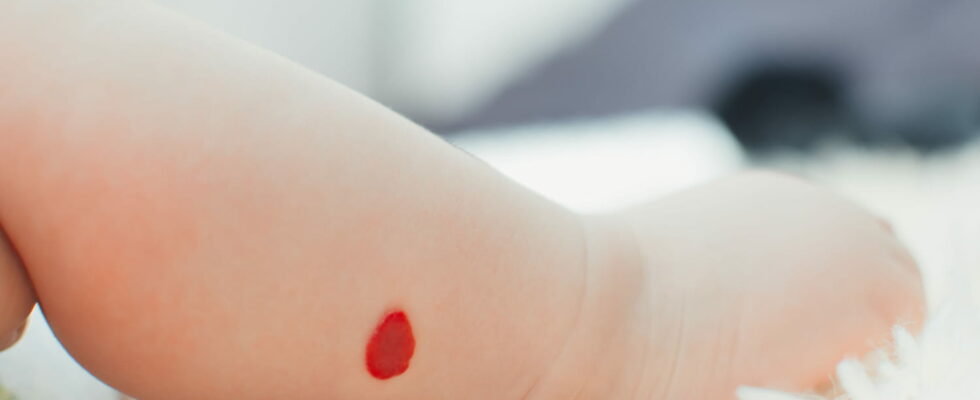There are several types of angiomas. These pathologies affect the skin of 10% of infants. What are the causes in the baby and how to treat them? Insight from Dr. Rakotonarivo, dermatologist.
Definition of angioma in babies
The angioma is a benign congenital malformation of the vascular or lymphatic system. There are several kinds. “Blood vessels in the skin are permanently overdilated and/or in excess number“says Dr. Rakotonarivo. In babies, there are several types, as the dermatologist explains. “There are basically two kinds of angiomas. Hemangioma or tuberous angiomaor “strawberry”, and the flat angioma or “wine stain”. It is also called the angel’s kiss or the stork’s bite.“.
What causes an angioma in babies?
The angioma is a unpredictable abnormality occurring during embryonic development. “It would seem that their frequency is increased in girls and premature babies, but the explanation has not yet been found.“, underlines the specialist before adding”Angiomas are also found in some congenital diseases or rare malformation syndromes“.
Where is an angioma located in the baby?
Face, neck, eyelid, face, hand… in babies, angioma affects the whole body as confirmed by the dermatologist. “It can appear absolutely anywhere. In exceptional cases, it can be found in the liver“.
What are the signs of angioma in babies?
The signs differ depending on the nature of the angioma. The flat angioma, for example, is seen from birth. “The dilated vessels give the skin a permanent pink to dark red colour. It becomes more noticeable with temperature changes and baby crying“, details Dr. Rakotonarivo. The hemangioma has other characteristics.”It constitutes a red to purple swelling on the skin, from a few millimeters to several centimeters, not detectable at birth, but which becomes visible after a few weeks of life. This free interval is characteristic“, indicates the dermatologist. This type of angioma then evolves until reaching its final size before the child is 12 months old. Apart from certain localizations, it does not cause no symptoms.
When and who to consult for an angioma?
For the specialist, it is possible to consult when the angioma is observed. “This reassures parents“, she explains. You have to get closer to a pediatrician or attending physician. “The latter will judge whether it is necessary to refer to a dermatologist. A quick consultation is strongly recommended in case of pain or local bleeding“, she advises.
Are angiomas dangerous?
Flat angiomas are benign. “The first risk is essentially aesthetic with sometimes difficulties of social integration“, Dr. Rakotonarivo expands. Facial hemangiomas, however, pose a functional risk depending on their location.”In the eye area, they can impair vision. On the mouth, they are likely to cause trouble breathing or feeding difficulties. If the nose is affected, the cartilage can be permanently deformed“list specialist before adding”Sometimes the hemangioma can become infected, ulcerate or even cause bleeding.
The vascular laser can be offered from the age of 6 months.
According to the professional, many hemangiomas fade or even disappear spontaneously before the age of 10-12 years, which is not flat angiomas that persist throughout life. “It is for these reasons that treatments are only offered in problematic or voluminous forms.“, she explains. There are also drug solutions. “The standard drug treatment is propranolol or Hemangiol®a beta-blocker in syrup prescribed to regress complex hemangiomas in babies from 1 month. The treatment begins in the hospital and is then renewed by the pediatrician or the dermatologist. It requires specific medical supervision. As a second intention, we use corticosteroids“ develops the dermatologist. The vascular laser is another solution. “It can be offered from the age of 6 months to treat flat angiomas. This technique being painful, it will be necessary to carry out a prior local or even general anesthesia” warns Louva Rakotonarivo. Finally, surgery is a last option.
Thanks to Dr. Louva Rakotonarivovenerologist dermatologist.
